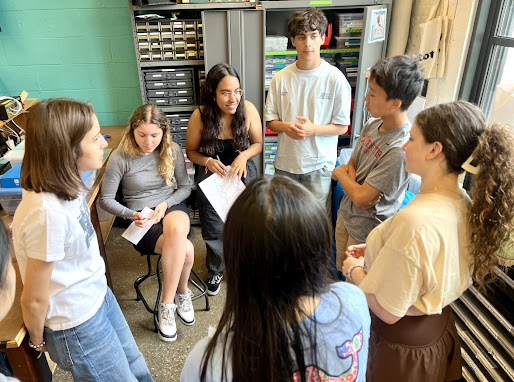" If you are going to have a conversation with the other person you are working with, we want you to try something we call the Five Whys.
For example, let's consider a conversation with Joel.
Facilitator: Joel, what's a project that you want to do this summer? It doesn't have to be anything special, just a random idea.
Joel: "The fish maze."
Facilitator: "Cool. Why do you want to make a fish maze?"
Joel: "I think it's pretty cool. You could probably take some random numbers out of it or maybe put some color into the fish so it could actually look kind of cool."
Facilitator: "So you're interested in the aesthetic side of things? You want it to look cool?"
Joel: "Yeah, imagine having this in your room or living room. Instead of having wood floors, imagine having fish going around like in a maze. That would be pretty cool."
Facilitator: "So, is this going to be a permanent installation somewhere?"
Joel: "It could be, yeah."
Facilitator: "And are you interested in specifically having fish?"
Joel: "I mean, we could probably put more stuff in there apart from fish, but water is definitely a must."
Facilitator: "Why water?"
Joel: "It looks good. The thing about water is you can paint stuff on it, which is cool. Sure, you could use ants or rabbits, but no one wants rabbits running around in their house. I already have plenty of ants in my house."
Facilitator: "Is there anything particular about fish? If there were little robots driving around in the water, would that be more or less entertaining?"
Joel: "It's more about nature. You feel more connected with live animals. Robots don't give the same feeling."
Facilitator: "So, having live animals moving around makes you feel more comfortable and connected?"
Joel: "Yeah, exactly."
That's the kind of conversation we want you to have. Initially, it seemed like Joel wanted to have fish in a maze for training purposes or similar reasons, but it turned out he was interested in the aesthetic appeal and the connection with live animals. That's the cool part of the project.
Now, you are going to talk to the person next to you, and they will come up with a project idea. Try to delve five levels down into why they care about this project. Not every question will be "why" because that would be boring. But aim to understand the core reason behind their interest.
Afterwards, we will call on random people, and you will pitch the other person's idea, explaining why they care about it. For instance, I would summarize this conversation about Joel's fish maze to the group.
Does everyone understand? Find a bit of space and take five minutes each for the conversation. Actually, let's make it four minutes each to keep it fast. Find a spot and start talking.
Next, we will discuss the reasons behind why you might want to do something. This will be harder, so we will give you some time to talk about it. Come up with three things each, and we will see if there is a lot of crossover. Mentors, could you please grab some pencils and paper for everyone? If you need more paper, there is some in my office around the corner.
The reason for the existence of initiatives like this is to push the boundaries of the impossible and make it possible. This means trying things that seem impossible until you achieve them. However, remember that you probably won't succeed on the first try.
Find a person you have never talked to before.
Listen to each other's ideas for 4 minutes each- then you will explain the other person's ideas.
What do you care about? Did the person want to do this project? Get to at least 3 whys. Do the 5 whys for yourself.
JFK: "We choose to go to the moon. We choose to go to the moon in this decade and do the other things, not because they are easy, but because they are hard, because that goal will serve to organize and measure the best of our energies and skills, because that challenge is one that we are willing to accept, one we are unwilling to postpone, and one which we intend to win, and the others, too. "












No comments:
Post a Comment